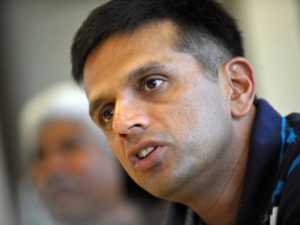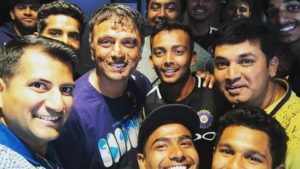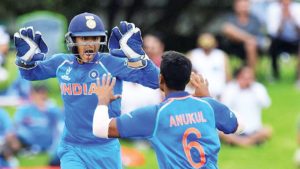Dravid and his family of happy Under-19s

By Gaurav Joshi
Every time a member of India’s victorious Under-19 team is quizzed about the World Cup they won on February 3 in New Zealand, the players are quick to highlight that the triumph was achieved not over three weeks but over a campaign that lasted two years. No wonder, then, on the eve of the final against Australia, India’s support staff — led by coach Rahul Dravid decided to dim the lights in the meeting room, turn on the projector and display a series of pictures and videos that summed up their journey from the first time they united at the National Cricket Academy in Bangalore late 2016 to the night before the World Cup final in Mount Maunganui.
For the duration of the 20-minute presentation, the players led by captain Prithvi Shaw chuckled, laughed, praised, appreciated and soaked in all the cheerful memories that included everything from spectacular catches, match winning festivities, the petrified faces during team-bonding activities and their dazzling performances. The purpose of this exercise was to simply keep the positive mindset afloat and to address any anxiousness ahead of the biggest cricket match of their young, teenage lives.

Twenty-four hours later, India thrashed Australia by eight wickets to lift the U-19 World Cup for the fourth occasion. Out of the four conquests, the 2018 victory was by far the most dominant by any team since the inauguration of the U-19 World Cup, all the way back in 1988.
The results will indicate that the World Cup was a stroll in the park, but that is largely due to the fact that the seeds to success had been planted ever since Dravid was appointed the coach of India’s U-19 team, three months before the 2016 U-19 World Cup in Bangladesh, a tournament in which India lost in the final.
Among the first steps taken, Dravid ensured the support staff from the previous World Cup was kept intact and then started with a clean sheet by assembling a squad capable of winning the title in two years’ time. From a coaching perspective it was a new challenge. In many ways, this generation of players symbolised the modern India. These boys had the tendency to be slightly brash and spent a majority of their free time on social media. They were also addicted to their smart phones and it would be fair to say that their attention spans were probably shorter than anyone the star-turned-coach would have encountered during his career as a cricketer.

Over time, Dravid and his support staff had built a rapport with the boys that created a vivacious and enthusiastic dressing room culture. Nothing captured this environment and their comfort level with their superstar coach better than during Dravid’s birthday, a few days before the tournament was to begin.

Not a single player hesitated for a moment to smear cake over the 45-year old legend’s face and also post the series of selfies across social media. Off-the-field, they had cultivated the culture of a happy family. This was soon going to reflect in their on-field performances as well.
In the opening match of the tournament, India annihilated Australia by 100 runs. It was a match that gave a glimpse of India’s ruthless attitude and all-round skill set. Shaw, India’s captain and a child prodigy earmarked for greatness, set the tone with a knock of 90 runs, during which his stroke-play drew comparisons with the great Sachin Tendulkar.
Not content with relying on his players’ talent, Dravid ensured that in the 12 months leading up to the World Cup that the squad got as much match practice as they could. India played two bilateral series against England, home and away, and also participated in the Asia Cup. Then, Dravid put in an official request to reach New Zealand (in Napier) nearly three weeks prior to the first game so Shaw & Co could acclimatise to the conditions by playing three matches against a local team (Central Districts A). The request was granted, of course.
Given their talent and form, India would barely raise a sweat in the next two pool matches as they trounced Papua New Guinea and Zimbabwe. In the latter contest, Shubman Gill was allowed to open the innings during the chase and fans of Indian cricket first lay their eyes on the emerging batting luminary. Gill, who smacked an unbeaten 90 in just 59 balls, was far less explosive off the field. Prone to addressing questioners in press conferences with ”˜sir’ or ”˜madam’ and seldom speaking unless spoken to, Gill was painted as a ”˜shy boy’ by the media. ”˜Not true’, revealed Shaw later.
There’s a backstory to this game. Six months ago, Bangladesh had knocked this Indian side out of the Asia Cup, a game in which tempers had flared and words were exchanged. This history apparently made Dravid nervous, and he is said to have spent a sleepless night before the match. But his boys were relaxed enough to win the game by 131 runs. At this point, their collective focus should’ve turned to Pakistan, who they were to meet in the semifinals. Instead, it was on a far greater distraction.
Two days before India’s semifinal game against Pakistan, the IPL auction was held in India, with many boys from this team on the bidding roster. Dealing with his players’ non-cricketing anxieties pushed Dravid into uncharted territory. “It was going to be a distraction and I could have ignored it, but instead we decided to address it and confront it as a group,” he told reporters later.
India would go on to decimate their arch-rivals by 203 runs in their penultimate match. Gill’s masterful century (102 not out) and fast bowler Ishan Porel’s superb opening spell of 6-2-17-4 were the main talking points of yet another polished performance. The conviction in these wins had already led to plenty of hype, fanfare and publicity, not just in India, but across New Zealand as well. On the day of the final, more than a thousand fans drove down from Auckland to Mount Maunganui, while about twice that number in the Waikato region decorated themselves in blue, as they cheered, danced, sang and embraced the rising stars.


India’s promising future cricketing stars, Manoj Kalra and Harvik Desai
Apart from the initial few overs in the final, where the occasion seemed to overawe Shaw’s team, India was largely untroubled. Chasing a modest total of 216 set by the Australians, Manjot Kalra hit a riveting century and ensured India won with eight wickets and 67 balls to spare. And the moment middle-order batsman Harvik Desai smacked the winning runs, a gruelling two-year journey had concluded in the most emphatic manner.
With the trophy secured under his arm, Dravid took his team on one final journey to the middle of the field. As they forged a team huddle, with gold medallions hanging around their necks, Dravid asked his players to cherish these memories forever, but continue to aim higher.
Short URL: https://indiandownunder.com.au/?p=10493
